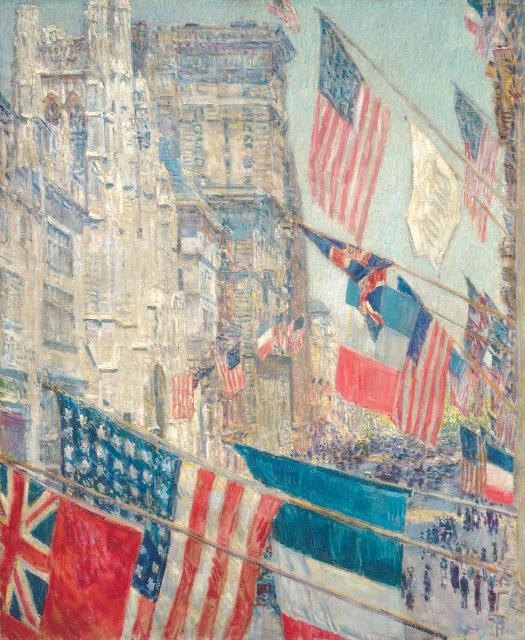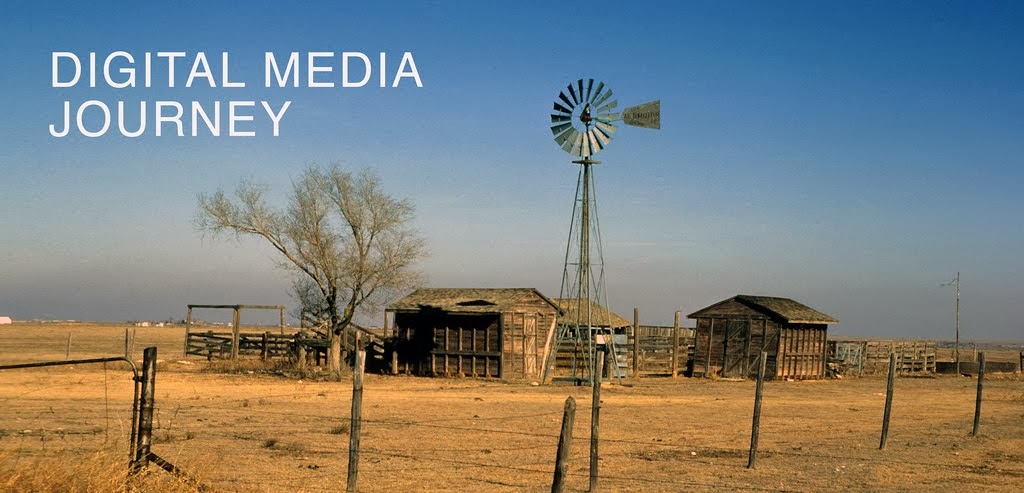 |
Childe Hassam,The Fourth of July, 1916 (The Greatest Display of the
American Flag Ever Seen in New York, Climax of the Preparedness
Parade in May), 1917, New-York Historical Society.
|
After War broke out in Europe in 1914, the American Impressionist Childe Hassam started in 1916 a Flag Series of about thirty works to encourage American to support the Preparedness Movement. Wilson the moralist wanted the United States to remain neutral so he would be in a stronger position to broker a compromise peace in Europe. Teddy Roosevelt, the carry a big stick practitioner of the realpolitik school was at the forefront of preparedness. Other famous proponents of preparedness were General Leonard Wood, Henry Stimson who was Secretary of War under President Taft, Admiral Dewey, and Elihu Root, Secretary of War under McKinley and Roosevelt. Neutrality was supported by immigrants from Scandinavia, Ireland, and Germany. Left wing socialists saw the war as an ideological corupt conflict between German militarism and British imperialism. Industrialists were divided. There was a strong pacifist movement in the rural protestant heartland of America.The Yiddish newspapers were initially pro German because of the pogroms and antisemitism in the Russian Empire. Irish American Catholics, were anti British, especially after the Easter Uprising of 1916 in Ireland to end British rule. Women and especially suffragists were strongly isolationists.
In 1914, the U.S. Army was about 100,000 and the National Guard wasn't much larger. The German army had about 4 1/2 million on active duty and in the reserves. The Preparedness Movement organized the Military Training Camps Association, where volunteer college graduates would receive officer training without any enlistment obligation. The summer camp in Plattsburgh NY was the most well known. Like most private summer camps it was attended by well to do elitists who didn't have to rely on a job to survive.
The Preparedness Movement gathered more momentum after the sinking of the British ocean liner Lusitania sailing from NY to Liverpool by a German U-boat off the coast of Ireland in May 1915. 128 U.S citizens died.
In September 1915, the silent film The Battle Cry of Peace was released. There were scenes of a foreign Army invading New York City. Bombs dropped on crowds in Times Square. The artillery from the coastal batteries falls short of an advancing fleet. Admiral Dewey, General Wood, and Secretary of War Lindley Garrison appear in the film to lend authenticity to what will happen if America is not prepared for war. The film received almost as much press and criticism as Birth of a Nation, released earlier that year. Henry Ford placed an article "Humanity and Sanity" in more than 250 newspapers alleging that munitions manufacturers had inspired the film. Vitagraph sued Ford for a million dollars.
Many viewers did not consider the invasion and slaughter of New Yorkers to be an impossible fantasy. Neutral Belgian, at the beginning of the war had been invaded by Germany during their advance to Paris. Germany considered Belgium civilians as dangerous as the small Belgium army and about 25,000 civilians died during executions, deportations, imprisonment, or being mistaken for snipers. There was widespread looting and burning of homes and public buildings. Louis Raemaekers, a Dutch newspaper cartoonist, went to Belgium to record the atrocities and convince neutral Netherlands that they needed to join the Allies. His cartoons also appeared in American newspapers. Later in the war the phrase Rape of Belgium, would be a propaganda slogan to promote the sale of War Bonds.
 |
Louis Raemaekers, The Hostages. The execution of the
Mayor of Aerschot, Belgium, together with his son and brother,
by the invading Germans, 20 August 1914.
|
Disagreeing with Wilson over Preparedness, was detrimental to a career. General Leonard Wood had been appointed Army Chief of Staff by President Taft in 1910. He returned to a command position after Wilson didn't reappoint him in 1914. Wood ran into more conflict with Wilson because he had authorized a regiment of Marines to be used as extras in the film Battle Cry of Peace. Wilson appointed John J. "Black Jack" Pershing to be Commander of the American Expeditionary Force and Wood was given a non-combat position training two divisions. Secretary of War Lindley Garrison conflicts with Wilson intensified after he wanted Wilson to intervene in the Mexican Revolution to restore order. Their conflict worsened over Wilson's neutrality about the War in Europe, and Garrison resigned in 1916. Assistant Secretary of War Henry Breckinridge also resigned out of loyalty to Garrison. Former Secretary of War Henry Stimson was selected by Teddy Roosevelt to be one of the officers to raise a volunteer unit. Wilson refused to use the unit. Stimson served in the regular army as an artillery officer. Admiral Dewey was too old and removed from politics to suffer from Wilson's vindictive personality.
The July 4, 1916 Preparedness Parade in New York City had over 100,000 marchers and lasted for over 12 hours. Hassam's flag paintings also included scenes of Fifth avenue without parades.
 |
Childe Hassam, Flags on the Waldorf, 1916
1916, Amon Carter Museum of American
Art, Fort Worth, Texas
|
 |
Childe Hassam, Rainy Day, Fifth Avenue,1916,1916,
Princeton University Art Museum, Princeton, NJ
|
 |
Childe Hassam, The Avenue in the Rain 1917, 1916.
The White House
|
The Avenue in the Rain 1917 was exhibited several times in 1916. The discrepancy in dates is probably because an incorrect label remains on the canvas stretcher.The Avenue in the Rain, 1917 is now part of the White House permanent collection. Clinton and Obama displayed the painting in the Oval Office.
 |
| Oval Office during the Clinton Administration |
 |
| Oval Office during the Obama years. |
President Trump had the painting replaced with a portrait of Andrew Jackson, the President who signed the Indian Removal Act of 1830. Unsettled lands west of the Mississippi were exchanged for Indian lands within existing state borders. A few tribes went peacefully, but most resisted the relocation policy. Cherokees were forcibly moved west and approximately 4,000 died on this forced march, now known as the "Trail of Tears."
Trump invited Navajo Code Talkers to the White House for recognition of their service during the Second World War. It was at this ceremony by the portrait of Jackson, that Trump referred to Senator Elizabeth Warren as Pocahontas.
Two events in 1917 made it impossible for Wilson to continue to remain neutral. In January, a secret diplomatic communication from the German Foreign Office to the German Ambassador in Mexico proposed a military alliance between Germany and Mexico in exchange for Texas, Arizona, and New Mexico. Americans were furious especially since Pancho Villa had launched a raid into the town of Columbus, New Mexico the year previously.
On February 1, 1917 the German Government announced it would again conduct unrestricted submarine warfare. Five American ships were sunk by German U-boats during the next two months.
A month after the United States entered the War, New York displayed French, British, and American Flags to welcome British and French War Commisioners
 |
Allies Day, May 1917, 1917, National Gallery of Art, Washington, D.C.
|
On the west (left) side of Fifth Avenue is the St. Thomas Church, completed three years earlier in a Gothic Revival style. Beyond it is the University Club in a Renaissance Revival style. Next is the Gotham Hotel in neoclassical style. The last building visible is the Fifth Avenue Presbyterian Church. The large flags are pointing to the buildings that were frequented by the elite of the city. Preparedness Parades were to convince the elite of the Government and didn't go through crime infested slums. A subtle message is that we use similar architectural language and shouldn't be Isolationist. The flags pointing to the bright illuminated churches in the sunlight implies which side God favors.
 |
| Avenue of the Allies: Great Britain, 1918 |
In 1918, Fifth Avenue between 33rd and
59th Streets would become known as Avenue of the Allies . For the fourth
Liberty Loan Drive Parade each of the Allies had a section of the avenue for
their flags. In the above painting, The flags of Great Britain and
Canada are from 53rd Street to 54th Streets. Brazil is at 55th Street and
Belgium is at 56th Street.
 |
| Claude Monet, The Rue Montorgueil in Paris. Celebration of June 30, 1878 |
When French Impressionism is compared to American Impressionism some authors will comment that the brush strokes in French Impressionism are looser and shorter and that there is more abstraction and blurring with a sense of motion. True, there is more naturalism to the buildings in Allies Day, May 1917, but the people on the street in The Avenue in the Rain are abstracted. The French with some exceptions abandoned Impressionism and embraced the avante-garde and the rapid succession of "isms" of the 20 th Century. Impressionism had a much longer run in the United States, especially in the Art Colonies along the California coast through the twentieth Century . There were too many individualistic styles of American Impressionism to make such comparisons meaningful.









